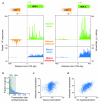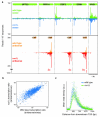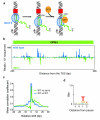Nascent transcript sequencing visualizes transcription at nucleotide resolution
- PMID: 21248844
- PMCID: PMC3880149
- DOI: 10.1038/nature09652
Nascent transcript sequencing visualizes transcription at nucleotide resolution
Abstract
Recent studies of transcription have revealed a level of complexity not previously appreciated even a few years ago, both in the intricate use of post-initiation control and the mass production of rapidly degraded transcripts. Dissection of these pathways requires strategies for precisely following transcripts as they are being produced. Here we present an approach (native elongating transcript sequencing, NET-seq), based on deep sequencing of 3' ends of nascent transcripts associated with RNA polymerase, to monitor transcription at nucleotide resolution. Application of NET-seq in Saccharomyces cerevisiae reveals that although promoters are generally capable of divergent transcription, the Rpd3S deacetylation complex enforces strong directionality to most promoters by suppressing antisense transcript initiation. Our studies also reveal pervasive polymerase pausing and backtracking throughout the body of transcripts. Average pause density shows prominent peaks at each of the first four nucleosomes, with the peak location occurring in good agreement with in vitro biophysical measurements. Thus, nucleosome-induced pausing represents a major barrier to transcriptional elongation in vivo.
Figures






Comment in
-
Gene expression: Teasing out transcription.Nat Rev Mol Cell Biol. 2011 Mar;12(3):138-9. doi: 10.1038/nrm3066. Epub 2011 Feb 9. Nat Rev Mol Cell Biol. 2011. PMID: 21304551 No abstract available.
-
Gene expression: Teasing out transcription.Nat Rev Genet. 2011 Mar;12(3):152. doi: 10.1038/nrg2959. Nat Rev Genet. 2011. PMID: 21331084 No abstract available.
References
-
- Moore MJ, Proudfoot NJ. Pre-mRNA processing reaches back to transcription and ahead to translation. Cell. 2009;136:688–700. - PubMed
-
- Preker P, et al. RNA exosome depletion reveals transcription upstream of active human promoters. Science. 2008;322:1851–1854. - PubMed
-
- Neil H, et al. Widespread bidirectional promoters are the major source of cryptic transcripts in yeast. Nature. 2009;457:1038–1042. - PubMed
-
- Rougvie AE, Lis JT. The RNA polymeraseII molecule at the end of the uninduced hsp70 gene of D.melanogaster is transcriptionallyengaged. Cell. 1988;54:795–804. - PubMed
Publication types
MeSH terms
Substances
Associated data
- Actions
Grants and funding
LinkOut - more resources
Full Text Sources
Other Literature Sources
Molecular Biology Databases

